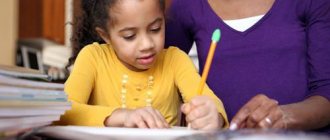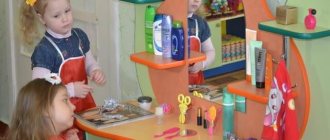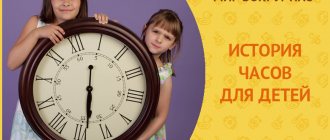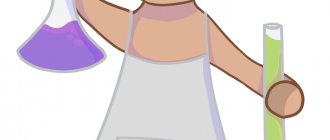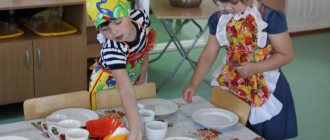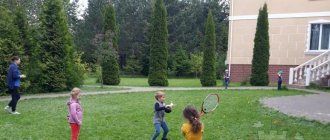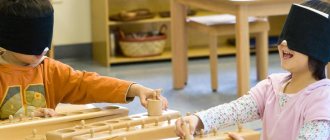Puppet theater and its influence on the development of speech in preschool children
Definition 1
Speech is a significant element of human activity, which allows a person to understand the world around him, transfer his knowledge and experience to other people, and accumulate it for transmission to subsequent generations.
Speech is also a means of expressing thoughts; in the course of its ontogenetic development, speech has become the main mechanism of human thinking.
In preschool age, the need for verbal communication with adults and peers determines the development of the child’s personality and his attitude towards the environment. The importance of speech in the development of a preschooler is one of the pressing issues of pedagogy, since it is cognitive communication and help from others that can direct his knowledge in the right direction, which is important for the formation of a future personality.
Are you an expert in this subject area? We invite you to become the author of the Directory Working Conditions
Puppet theater is one of the most accessible forms of art for children, with the help of which many pressing pedagogical problems can be solved, namely:
- art education and parenting;
- formation of aesthetic taste in children;
- moral education of children;
- development of personal communication skills;
- education of will, development of memory, imagination, initiative, fantasy and speech;
- creating a positive emotional mood, relieving tension in children.
Puppet theater acts as a means of emotional and aesthetic education of preschool children. Thanks to the theater, the child learns about the world and learns to express his own attitude towards good and evil.
By using a puppet theater you can solve many problems:
- expand children’s understanding of reality - different types of theaters, professions of people who create the performance, etc.;
- develop memory, children learn to plan their own actions in order to achieve a certain result;
- ensure the relationship between construction and theatrical play so that dynamic spatial representations develop.
Finished works on a similar topic
Course work Puppet theater as a means of developing the speech of preschoolers 430 ₽ Abstract Puppet theater as a means of developing the speech of preschoolers 280 ₽ Test work Puppet theater as a means of developing the speech of preschoolers 250 ₽
Receive completed work or specialist advice on your educational project Find out the cost
Speech development promotes the development of monologue and dialogic speech, enriches the vocabulary with figurative expressions, epithets, comparisons, antonyms, synonyms, etc., helps to master expressive means of communication, both verbal and non-verbal.
During the performance of skits in a puppet theater:
- aesthetic problems are solved - children learn to independently invent images and become familiar with fiction, imagination develops, children create an expressive artistic image and become involved in independent activities aimed at modeling costumes, scenery and attributes.
- movements are developing - children learn to coordinate their actions with the speech that accompanies them.
- children become friendlier, help each other, make dolls together.
What does the performance mean?
spectaculum “spectacle”) - theatrical spectacle, performance, work of theatrical, stage art; can be staged both on the theater and circus stage, and on the radio (radio play) and on television (television play, film-play), in cinema (film-plays, film operas, etc.). ...
Interesting materials:
What is the name of the organization that provides Internet connection services? What is the name of the main part of the ship? What is the name of the main commercial fish that is the object of sport fishing? What is the name of the main organ of the urinary system? What is the name of the spicy Italian sausage for pizza? What is the name of the spicy Italian sausage used in pizza toppings? What is the name of spicy Italian sausage? What is the name of the island on which Sam's house from The Lord of the Rings is located? What is the name of the island on which Sam's house is located, a character from one famous English novel? What is the name of the island on which Iceland is located?
MAGAZINE Preschooler.RF
“Types of puppet theaters in kindergarten and at home. Making theatrical puppets"The world of theater is a path to the inner feelings of a child, his soul. L.S. Wygodsky
What is theater?
This is the best, according to K.S. Stanislavsky, a means for communication between people, for understanding their innermost feelings. This miracle is capable of developing creative inclinations in a child, stimulating the development of mental processes, improving bodily plasticity, and forming creative activity; help reduce the spiritual gap between adults and children
Theater is a collective theatrical activity, and it is aimed at a holistic impact on the child’s personality. The child becomes liberated, begins to create independently, through the theater the child gets to know himself and begins to grow as a person. Theater creates conditions for the socialization of a child in society, strengthens adaptive abilities, corrects communication skills, and helps to realize a sense of satisfaction, joy, and success.
The prosperity and development of theatrical activities in kindergarten is not possible without the use of puppet theater. It is the main link in the development and improvement of children’s knowledge in the field of theatrical art. Puppet theater is one of the most favorite shows for children. It attracts with its brightness, colorfulness, and dynamics. In the puppet theater, children see toys that are familiar and close to them, which come to life and move, speak and become even more attractive and interesting. Puppet theater brings a lot of pleasure and joy. It is one of the most accessible forms of art for children.
Types of puppet theaters
- Tabletop puppet theater.
- Stand theater.
- Theater on hand.
- Horse dolls.
- Floor dolls.
- Living puppet theater.
- Tabletop puppet theater. Toys for a tabletop theater can be made of paper, foam rubber, boxes, wire, natural materials, etc.
- Theater on a flat picture
- Theater on circles
- Conical
- Toy Theater
- Flat toys
Draw two sides of the character on the cardboard and cut them out; at the bottom you need to leave a small part of the cardboard on both halves. Then bend these parts and glue a circle to them - a stand. You can also use the following as a stand: caps from plastic bottles, halves of Kinder eggs, etc.
- theater on a flat picture
- Theater on circles
- Cut out a picture of the character and stick it on a mug or glass.
- Cone Theater
Toys made from cones and cylinders.
To get a cone, you need to cut out a circle, fold it in half and cut along the fold line. Glue cones from semicircles, turning them into figures, and glue the parts.
To get a cylinder, glue them together from rectangular sheets of thick paper. Decorate with applique by gluing character details
Toy theater
Ready-made and homemade from different materials: kinder eggs, flour salt, plasticine, etc.
Tabletop theater
Tabletop theater may also include: theaters of knitted toys, theaters from boxes, on disks, on cubes and many others.
2. Stand theater
- Flannelograph
- Shadow play
- Magnetic
- Stand book
Flannelograph Draw figures on thin cardboard, cut them out, and stick pieces of flannel on the reverse sides. Screen – thick cardboard or plywood covered with a piece of flannel
Shadow theater
1. Finger.
Cut out the character's head from cardboard and glue a paper tube to it for the performer's index finger. The performer's hand is the character's torso, and the middle and thumb are the legs.
2. Theater of “live” hand shadows.
Using the fingers, various animals, birds, objects, etc. are depicted.
3. . Cut out silhouettes.
Cut out different silhouettes from cardboard and stick them on long sticks. During the show, the silhouette must be held by the stick and moved as necessary.
Shadow screen device.
The screen is made from any translucent material (fabric, tracing paper), stretched over a frame made of plywood, cardboard, installed like an ordinary screen, and a light source - a lamp - is installed behind it.
The theatrical performance is also shown from the reverse side. Only the silhouettes of the characters are visible in front
Magnetic Theater
Glue a piece of magnet onto the cardboard with the image of the character on the back side. The theater is ready for use
Stand – book
3. Theater on hand
The characters are placed on the hand of a child or an adult; when the fingers move, the impression of the character’s movement is created.
- Finger
- Mittens
- Glove
- Theater on hand
1Finger
Characters for finger theater can be made from different materials: knitted from threads, sewn from fabric, from foam rubber, etc.
22. Mitten Theater.
Characters are sewn from
fabrics in the form of mittens. It can represent a doll's head, with the thumb serving as the character's nose. It can also be turned into a whole animal, then the thumb will be the tail, and the mitten itself will be the body, the head and other details are sewn to it. You can use old unnecessary mittens.
3 Glove.
The head, clothes, and necessary details of the character are sewn onto the glove.
4. Horse dolls
Puppets that are necessary when showing theatrical action using a screen.
On spoons
Bibabo
Cane puppets
1 Theater on spoons - The oval or round part of the spoon is shaped like a head (thread hair, eyes, mouth, etc.), then the body is attached to the head in the form of a dress, a shirt - a piece of fabric.
2 cane dolls - Cane dolls can be made in the form of a toy on a stick - a cane or in the form of a cardboard toy, which is also glued to a stick.
3Bibabo -The doll's head is placed on the index finger, and the thumb and middle finger serve as hands. Dresses are sewn for them, decorated with details (pocket, apron, belt). The heads can be made of foam rubber, fabric, papier-mâché. For the head, you need to make a circle from any fabric, gather it around the perimeter with a thread, and stuff it with cotton wool. Sew on nose, hair, etc.
5Floor dolls
Puppets.
Puppet theater characters are also made from different materials. The parts can be sewn according to the principle of making a soft toy using a template - a pattern, which is applied to the fabric, outlined with chalk, cut out, and simple parts are sewn together. The principle of operation of such toys is thanks to a fishing line tied to the cross.
6 Living Puppet Theater
- Puppets
- People dolls
- Masque
Puppet theater is a wonderful journey into the land of a fairy tale come to life! Not only every child, but also an adult who has retained a living perception of life in their hearts, crosses the theater threshold with a justified expectation of miracles and magic! It is here, seeing the heroes of books and fairy tales come to life, that the child begins to learn the joy of co-creation, empathy, and love of art in the broadest sense of the word!
I wish everyone creative success in mastering theatrical art.
| Next > |
How to make your own screen for a theater in a preschool educational institution
In order to organize theatrical activities with preschoolers, you will need various attributes, including masks, dolls, and decorations. Of course, the necessary equipment can be purchased in specialized stores. But by inviting children to make the necessary equipment for the theatricalization of a fairy tale, it is possible not only to diversify the educational process of preschoolers, increase motivation for work, but also to realize the main educational and educational goals.
What can you use to make a theater for preschoolers? For most types of such creative activities, a theater screen is required. In kindergarten, there is usually the specified equipment either in the playroom or in the music room. But if you don’t have a screen of the required size, you can make it yourself.
The easiest way to make such an attribute for a theatrical game is to stretch thick fabric over the doorway. Depending on what type of activity is supposed to be carried out, a “window” is either cut out in the material or an indentation is made at the top to accommodate the characters.
The influence of theatrical play on the development of a preschooler
It is impossible to overestimate the beneficial impact of theatrical games on the development of preschool children. This activity contributes to:
- children’s learning and retention of educational material;
- development of speech and fine motor skills;
- formation of communication skills;
- development of creative abilities, identification of children’s talents;
- developing the ability to interact with others;
- the formation of the sensitive-emotional sphere;
- the emergence of a sustainable interest in fiction and books;
- education of aesthetic taste;
- development of such personal qualities as determination, will, initiative and others.
Materials for making characters
What else can you make puppet theater characters from:
- cardboard, making two holes for fingers in the lower part;
- matchboxes;
- tennis balls;
- inflatable balloons;
- disposable tableware: plates, cups, spoons;
- socks, mittens, gloves;
- plastic bottles;
- natural material, etc.
Thus, you can organize different types of theaters in kindergarten. When planning such activities, it is important for the teacher to take into account the age and individual characteristics of the students and their interests. In addition, it is necessary not only to correctly conduct a theatrical game, but also to methodically correctly think through the preparatory and final stages of working with children. The effectiveness of pedagogical work with preschoolers in general depends on these factors.
Purpose: to familiarize yourself with the characteristics of the age characteristics of preschoolers in theatrical activities in terms of the requirements of the “I am in the World” program
Practical tasks:
1. Familiarize yourself with the age characteristics in the theatrical activities of children of early, younger, and older age. Make brief abstracts, indicating complications.
2. Prepare to answer the following questions:
- what is the complexity of the skills of perception of theatrical spectacle;
— how difficult is it to convey the text of a literary work in theatrical and play activities;
— what types of theater, in your opinion, are used in early age groups;
— what content blocks a child of senior preschool age can master when getting acquainted with the theater.
1. Goals, objectives and content of work with children of primary preschool age
The main directions of development of theatrical play consist in the child’s gradual transition:
- from observing a theatrical performance by an adult to independent play activity;
- from individual play and “side-by-side play” to play in a group of three to five peers playing roles;
- from imitation of the actions of folklore and literary characters to imitation of actions in combination with the transfer of the main emotions of the hero and mastering the role as the creation of a simple “typical” image in a dramatization game.
Objectives and content of the work.
- To develop an interest in theatrical games that develops in the process of watching small puppet shows that the teacher shows, taking as a basis the content of nursery rhymes, poems and fairy tales familiar to the child.
- Stimulate children's desire to participate in the performance by complementing individual phrases in the dialogues of the characters, stable phrases of the beginning and ending of the fairy tale.
- Glove and other theatrical puppets are used in classes and in everyday communication.
- On behalf of the characters, the adult thanks and praises the children, says hello and goodbye.
- Consistently increasing the complexity of game tasks and dramatization games in which the child is involved.
Forms of work:
• A game-imitation of individual actions of humans, animals and birds (children woke up, stretched, sparrows flapped their wings) and imitation of basic human emotions (the sun came out - the children were happy: they smiled, clapped their hands, jumped in place).
• A game-imitation of a chain of sequential actions combined with the transfer of the main emotions of the hero (cheerful nesting dolls clapped their hands and began to dance; the bunny saw a fox, got scared and jumped onto a tree).
• A game that imitates the images of well-known fairy-tale characters (a clumsy bear walks towards the house, a brave cockerel walks along the path).
• Improvisation game to music (“Cheerful Rain”, “Leaves fly in the wind and fall on the path”, “Round dance around the Christmas tree”).
• Wordless game - improvisation with one character based on the texts of poems and jokes that the teacher reads (“Katya, Little Katya.”, “Baby, dance.”, V. Berestov “Sick Doll”, A. Barto “Snow, Snow”)
• Game-improvisation based on the texts of short fairy tales, stories and poems told by the teacher (3. Alexandrova “Christmas tree”; K. Ushinsky “Cockerel with his family”, “Vaska”; N. Pavlova “By the car”, “Strawberry”; V Charushin "Duck with ducklings")
Role-playing dialogue between fairy tale heroes (“Rukavichka”, “Zayushkina’s Hut”, “Three Bears”)
• Dramatization of fragments of fairy tales about animals (“Teremok”, “Cat, Rooster and Fox”)
• Game-dramatization with several characters based on folk tales (“Kolobok”, “Turnip”) and author’s texts (V. Suteev “Under the Mushroom”, K. Chukovsky “Chicken”).
In children of this age, primary development of director's theatrical play is noted:
- tabletop toy theater,
- tabletop flat theater,
- flat theater on flannelgraph
- finger theater
The process of mastering includes mini-productions based on the texts of folk and original poems, fairy tales, stories (“This finger is a grandfather.”, “Tili-bom”, K. Ushinsky “Cockerel with the Family”, A. Barto “Toys”, V. Suteev “Chicken and Duckling.”) The child begins to use finger theater figures in joint improvisations with an adult on given topics.
In younger groups, children do not reproduce the text, but perform certain actions according to the model shown by the teacher. Such simulation games activate children’s imagination and prepare them for independent creative play. They are happy to transform into familiar animals, but they cannot yet develop and play out the plot.
Interest in theatrical games develops in the process of watching performances shown by the teacher. Children accept them joyfully and emotionally. The artistry and emotionality of the teacher are very important here. The smaller the child, the more expressive the game should be. Thus, due to wordless play - improvisation to music,
games - improvisations based on the texts of short fairy tales, nursery rhymes and poems, role-playing dialogues of fairy tale heroes, dramatizations of fragments of fairy tales about animals and
games - dramatizations with several characters expand the gaming experience of children. Gradually, children become involved in the process of playful communication with theatrical dolls; children develop a desire to participate in playful dramatic miniatures.
Children’s gaming experience is enriched through the development of special gaming skills:
Mastering the position of “spectator” - watch and listen to the end, thank the artists.
Primary formation of the “artist” position (the ability to use certain means of expressiveness to convey the image of a character, his emotions, experiences; the ability to play out the character’s actions with the help of a doll)
The ability to interact with other children, play roles they like.
2. Goals, objectives and content of work with children of middle preschool age.
The main directions of development of theatrical play consist in the child’s gradual transition from:
- games “for yourself” to a game focused on the viewer, where not only the game is important, but the result is also important..
- play becomes a means of self-expression, children learn to combine text and movement in roles, and a sense of partnership develops;
- from a game in which the most important thing is the process itself, to a game where both the process and the result are significant;
- first-person narratives are introduced accompanied by text, movements and music;
- from playing in a small group of peers playing similar (“parallel”) roles, to playing in a group of five to seven peers whose role positions are different (equality, subordination, control);
- from creating a simple “typical” image in a dramatization game to the embodiment of a holistic image that combines emotions, moods, states of the hero, and their changes.
Objectives and content of the work
- Deepening interest in theatrical games.
- The work of a teacher with children is to maintain interest in theatrical play, to prefer a certain type of play (dramatization or directing), and to develop motivation for interest in play as a means of self-expression.
- The theatrical and gaming experience of children is expanded through games - dramatizations using several characters, games where children get acquainted with the work of adults, performances based on the works of domestic and foreign authors, tabletop, puppet, and finger theater. The content is based on play studies of a reproductive and improvised nature. Particular attention is paid to improvisation and creativity in the process of inventing the game.
- Children's theatrical and playing skills become more complex;
- Further development of the “spectator” position (show elements of spectator culture, positively evaluate the play of peers).
- The ability to use means of non-verbal and intonation expressiveness to convey the image of a character, the ability to control a doll or toy, conveying its gestures and movements.
- Primary mastery of the “director” position, the ability to create playing space on the table plane.
- The ability to master the qualities of a performance designer.
- The ability to interact positively with other participants in the game, negotiate the distribution of roles and be able to resolve conflict situations.
In addition to the games mentioned above, the following are used when working with children:
• multi-character games-dramatizations based on the texts of two-three-part fairy tales about animals and fairy tales (“Winter Quarters of Animals”, “The Fox and the Wolf”, “Geese-Swans”, “Little Red Riding Hood”);
• dramatization games based on the texts of stories on the topics “Children and their games”, “Guys and animals”, “The work of adults”;
• staging a performance based on the work.
The expansion of children's gaming experience also occurs through the development of theatrical play.
At the age of 4-5 years, a child masters different types of tabletop theater:
- soft toys,
- wooden theater,
- cone theater,
- folk toy theater
- planar figures,
- puppet theater (without a screen, and by the end of the school year - with a screen), etc.
Children show performances based on poetic and prose texts (S. Marshak “The Tale of a Stupid Mouse”; K. Chukovsky “Confusion”). Finger theater is more often used in independent activities, when a child improvises based on familiar poems and nursery rhymes, accompanying his speech with simple actions (“We lived with grandma”; S. Mikhalkov “Kittens”, 3ubkova “We shared an orange”).
3. Goals, objectives and content of work with children of senior preschool age.
The main directions of development of theatrical play consist in the child’s gradual transition:
• from a game based on one literary or folklore text to a game in which the literary basis is combined with its free interpretation by the child or several works are combined;
• from a game where expressive means are used to convey the characteristics of a character, to a game as a means of self-expression through the image of a hero;
• from a game in which , to a game in which a complex of positions is presented: “artist”, “director”, “screenwriter”, “designer”, “costume designer”;
• from theatrical play to theatrical play activity as a means of personal self-expression and self-realization of abilities.
Objectives and content of the work:
- formation of a positive attitude of children towards theatrical games
- (deepening their interest in a certain type of theatrical play, the image of the hero, the plot, the presence of interest in theatrical culture);
- introducing children to theatrical culture (familiarity with the purpose of the theater, the history of its origin, the structure of the theater building, the activities of people working in the theater, prominent representatives of these professions, types and genres of theatrical art (dramatic, musical, puppetry, animal theater, clowning, etc.) );
- deepening theatrical gaming experience through mastering different types of dramatization games and director's theatrical games.
figurative play sketches;
- improvisation games;
- independent productions of performances, including those based on a “collage” of several literary works.
For example, “Journey through the fairy tales of A. S. Pushkin”, “New adventures of the heroes of fairy tales by C. Perrault”, etc.
The experience of directing is enriched by the use of puppets, dolls with a “living hand,” and cane puppets.
In the older group, children continue to improve their performing skills.
Dramatization becomes performance. Children play for spectators. This requires the entire stock of knowledge, skills and abilities acquired at different ages.
To better understand a literary work, it is necessary to look at its illustrations and pay attention to the emotional state of the characters;
select exercises to develop attention and imagination;
emotionally express the character’s state using intonation, facial expressions, gestures and posing.
Be able to tune yourself with the help of special exercises to perform upcoming actions, change facial expressions and posture when switching from one action to another. To do this, it is necessary to use fairy tales rich in dialogues and dynamic lines. This will enrich children's speech with new expressive means.
It is important to give children more freedom in action and imagination when simulating movements. Joint creative activity involves even insufficiently active children in the process of staging performances, thereby helping them overcome shyness and constraint.
It is necessary to organize excursions, observe the surroundings, conduct play exercises for imagination, use mimic and pantomime sketches in work, involve children in inventing and designing fairy tales and display all their emotions and experiences in visual activities.
Texts for productions are becoming more complex. They are distinguished by a deeper moral meaning and hidden subtext, including humorous ones.
In theatrical play, Russian folk tales and fables about animals begin to be used (“The Fox and the Crane,” “The Hare and the Hedgehog,” works by L. Tolstoy, I. Krylov, G. H. Andersen, M. Zoshchenko, N. Nosov.
Fantasy play becomes the basis of theatrical play, where literary and fantasy characters coexist.
Special skills are developed:
The “spectator” becomes an assistant and advisor.
The “artist” independently expresses his attitude towards the character using means of non-verbal and verbal expressiveness.
The “director” is able to realize his plans independently.
For older preschoolers, “continued” games are typical. They also master a new game for themselves, “To the Theater,” which involves a combination of role-playing and theatrical play, based on familiarity with the theater and the activities of the people participating in the production of the play.
Children show independence in a more vibrant and diverse manner.
4. What types of theater are used in early age groups
- Finger Theater
- Glove Theater
- Theater of mittens. Puppets for the mitten theater can be made from old mittens, mittens, or knitted from matching threads. The design uses an applique of pieces of thick fabric in bright colors (a person, an animal, a flower, etc.). It is sewn to the inside of the mitten and the image is completed by sewing on missing details cut from fabric or made from threads (ears, antennae, bows, etc.)
- Toy theater
- Theater of Pictures (flannelograph)
- Theater of mugs. Making such a theater is very simple. To do this, take plastic mugs of the same size and color, turn them upside down and glue a picture of a character drawn or cut out from old children's books to the side of the handle. In this way, all the heroes for the fairy tale are made. The mug theater is ready.
5. What content blocks can a child of senior preschool age master when getting acquainted with the theater?
- Speech
- Informative
- Artistic and aesthetic
- Emotional-value
- Socio-moral
- Creative
Living Puppet Theater
But more often than others, a “live” puppet theater is organized in kindergarten. Such activities can be carried out as a lesson on the development of speech, the surrounding world, learning a foreign language, as well as during leisure time. In addition, a live theater production can be dedicated to a holiday, for example, Maslenitsa or New Year.
The following types of described gaming activities are distinguished:
- masque;
- theater of giant puppets.
The latter is most often carried out as a leisure activity in a preschool educational institution. The roles of giant dolls are played either by adults or older preschoolers. Younger children can only act as spectators.
Then the mask theater is suitable for children of any age. Even the youngest pupils have the opportunity to “reincarnate” into the hero of a fairy tale. The teacher can invite the children to retell a story the kids love in such an unusual way or prepare a full-fledged performance for their parents.
Preschoolers can make masks for the upcoming performance on their own under the guidance of a teacher, for example, during classes on artistic and aesthetic development or during leisure activities.
"Rar" theater
This type includes theatrical activities, which require attributes such as finger puppets or “glove” toys. There are the following “wrist” types of theaters in kindergarten:
- finger;
- glove
What is needed to organize such theatrical activities? First of all, you need a screen. Its size depends directly on the size of the characters. In turn, dolls are most often made independently by the teacher. But students can also take an active part in creating characters. For example, you can make finger puppets from cardboard cones, fabric, tennis balls and other materials.
“Glove puppets” can be made, for example, from a mitten or sock, sewing the necessary elements (face, hands, clothes, etc.) to the base.
It is important to note that finger theater, in addition to other advantages, effectively develops fine motor skills of preschoolers, which, in turn, directly affects the formation of children’s speech.
Floor theater
Floor theater uses puppets. Making them yourself is quite difficult, so most often they are purchased in specialized stores. Due to this feature, this type of theatrical activity is rarely carried out in kindergartens. But it is the puppet theater that evokes a storm of emotions and delight in preschoolers. Since children do not yet understand the mechanism of action of such dolls, children imagine that the toys themselves have “come to life”. It is this element of “miracle”, “fairy tale” that contributes to the emergence of positive emotions in preschoolers.
